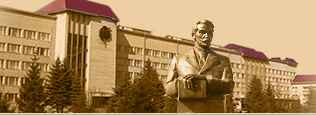THE FORMATION OF THE STRUCTURE OF NATURAL-ANTHROPOGENIC LANDSCAPES OF GOMEL POLESIE
In the article the features of the economic land development of the territory of Gomel Polesye from the initial stages up to the modern period are considered by means of the spatial analyses of the settlement system, the land use area change and the forest-land percentage of the territory. The tendencies of the land use structure change from the middle of the 19th century to the end of the 20th century manifesting in reducing natural territories and their replacement by agricultural and built-up lands have been established. On the whole, for the territory of Gomel Polesye during the highlighted period a decrease in the area of forest and swampy lands and a general increase in the agricultural land area by 1,7 times have been characteristic, moreover, a significant increase in the area of inhabited localities (by 2 times) has been observed. The patterns of formation and changing of classes and subclasses of natural-anthropogenic landscapes (NAL) in accordance with their initial natural structure have been determined. Significant differences in the change of the land use structure have been noted for individual areas of landscapes, especially within the moraine-outwash landscapes. The least transformations have occurred within the alluvial-terraced landscapes. The initial pattern of transformation of the landscape structure from forest landscape to forestry, agricultural-forestry, and agricultural natural-anthropogenic landscapes in the zones of economic influence of settlements has been ascertained. In the XIX century the predominant class of natural-anthropogenic landscapes was the forest class making up 52,4% of the territory of Gomel Polesye with the prevalence of the forestry subclass. Agricultural-forest NALs occupied 20.6% of the territory and were mainly situated within the secondary water-glacial and moraine-outwash landscapes. Agricultural lands covered 27% of the area, mainly within the secondary moraine, moraine-outwash and floodplain landscapes. At the end of the 20th century the agricultural-forestry type starts to prevail, occupying up to 62.6% of the territory, with the predominance of the arable-forest NAL. The area of the agricultural class has remained unchanged (27%) with a significant change in the structure of the subclasses: the residential-arable subclass has become prevailing, the meadow-arable landscapes are replaced by the arable ones that are the most developed and transformed. Furthermore, a partial replacement of forestry landscapes with arable-forest ones has occurred. While the area of the forest class of NAL landscape has decreased by 4.8 times, it has preserved the structure of its subclasses. Time series of NAL changes have been determined, reflecting the changes in the structure of the landscapes of Gomel Polesye under the influence of the human activity.
Key words: natural-anthropogenic landscapes, economic development, land use structure, settlement system, classes and subclasses of natural-anthropogenic landscapes.
References:
- Landshafty Belorussii / pod red. G. I. Martsinkevich, N. K. Klitsunovoi. – Minsk : Universitetskoe, 1989. – 239 s.
- Martsinkevich G. I. Landshaftovedenie : ucheb. posobie / G.I. Martsinkevich, I.I. Schastnaya. – Minsk : IVTs Minfina, 2014. – 288 s.
- Arhealogija Belarusi : u 4 t. / pad. rjed. V. I. Shadyry, V. S. Vjargej. – Minsk : Belaruskaja navuka, 1997–2000. – T. 2. : Zhalezny vek i rannjae sjarjednevechcha / A. A. Egarjejchanka, V. I. Shadyra, V. S. Vjargej [i insh.]. – 1999. – 502 s.
- Garady i veski Belarusi: Jencyklapedyja : u 15 t. / rjedkal.: G. P. Pashkou (gal. rjed.) [i insh.]. – Minsk : BelJen, 2004 – 2011. – T. 1. – Kn. 1 : Gomel”skaja voblasc” / S. V. Marcjeleu. – 2004. – 632 s.
- Garady i veski Belarusi: Jencyklapedyja : u 15 t. /; rjedkal.: G. P. Pashkou (gal. rjed.) [i insh.]. – Minsk : BelJen, 2004 – 2011. – T. 2. – Kn. 2 : Gomel”skaja voblasc” / S. V. Marcjeleu [i insh.]. – 2004. – 520 s.
- Goroda, mestechki i zamki Velikogo knjazhestva Litovskogo : jenciklopedija / Pod red. T. V. Belova [i dr]. – Minsk : Belarus. Jencykl. imja P. Broўki, – 2009. – 312 s.
- Koshman V. И. Paselishcha mizhrjechcha Bjarjeziny i Dnjapra u H – HIII stagodzjah / V. И. Koshman. – Minsk : Belaruskaja navuka, 2008. – 281 s.
- Makushnikov O. A. Goroda i gorodishha Gomel’skogo Podneprov’ja v V – XIII vv. / O. A. Makushnikov // Izvestija GGU im F. Skoriny. – 2008. – № 4. – S. 92–99.
- Pobol’ L. D. Slavjanskie drevnosti Belorussii : svod arheologicheskih pa-mjatnikov rannego jetapa zarubineckoj kul’tury – s serediny ІІІ do n.je. po nachalo ІІ v. n.je. / L. D. Pobol’; red. Ju. V.Kuharenko; Akademija nauk Belorusskoj SSR, Institut is-torii. – Minsk : Nauka i tehnika, 1974. – 240 s.
- Kompleksnaja produktivnost’ zemel’ lesnogo fonda / V. F. Baginskij i dr., pod obshhej redakciej V. F. Baginskogo – Gomel’ : Institut lesa NAN Belarusi, 2007. – 295 s.
- Marcinkevich G. I. Funkcional’naja tipologija i struktura transformiro-vannyh landshaftov Belorusskogo Poles’ja / G. I. Marcinkevich, I. I. Schastnaja, I. P. Usova // Zemlja Belarusi. – 2010. – № 3. – S. 24–27.
- Landshaftnaja karta Belorusskoj SSR (Masshtab 1:600 000) / sost. N. K. Klicunova, G. I. Marcinkevich, G. T. Haranicheva, L. V. Loginova. – M : GUGK, 1984.
- Nizovcev V. A. Stanovlenie antropogennogo landshaftogeneza Moskovsko-go regiona / V. A. Nizovcev // Landshaftnyj sbornik (Razvitie idej N. A. Solnceva v sovremennom landshaftovedenii) / Pod red. Doktora geogr.nauk I. I. Mamaj. M. – Smo-lensk: Ojkumena. – 2013. – S. 196–226.
- Gusev A. P. Antropogennaja transformacija geosistem jugo-vostoka Belorus-sii v XVIII-XX vekah: landshaftno-jekologicheskij analiz / A. P. Gusev, S. V. Andrushko// Geograficheskij vestnik. – №3 (22). – 2012. S. 14–22.
